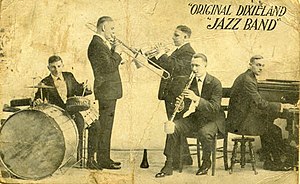
| Jazz standards and tunes |
|---|
| Before 1920 |
| 1920s |
| 1930s |
| 1940s |
| 1950s and later |
| A–Z of jazz standards and tunes |
Jazz standards are musical compositions that are widely known, performed and recorded by jazz artists as part of the genre's musical repertoire. This list includes compositions written before 1920 that are considered standards by at least one major fake book publication or reference work. Some of the tunes listed were instant hits and quickly became well-known standards, while others were popularized later. The time of the most influential recordings of a song, where appropriate, is indicated on the list.
From its conception at the change of the twentieth century, jazz was music intended for dancing. This influenced the choice of material played by early jazz groups: King Oliver's Creole Jazz Band, New Orleans Rhythm Kings and others included many Tin Pan Alley popular songs in their repertoire, and record companies often used their power to dictate which songs were to be recorded by their artists. Certain songs were pushed by recording executives and therefore quickly achieved standard status; this started with the first jazz recordings in 1917, when the Original Dixieland Jass Band recorded "Darktown Strutters' Ball" and "Indiana".[1] Originally simply called "jazz", the music of early jazz bands is today often referred to as "Dixieland" or "New Orleans jazz", to distinguish it from more recent subgenres.[2]
The origins of jazz are in the musical traditions of early twentieth-century New Orleans, including brass band music, the blues, ragtime and spirituals,[3] and some of the most popular early standards come from these influences. Ragtime songs "Twelfth Street Rag" and "Tiger Rag" have become popular numbers for jazz artists, as have blues tunes "St. Louis Blues" and "St. James Infirmary". Tin Pan Alley songwriters contributed several songs to the jazz standard repertoire, including "Indiana" and "After You've Gone". Others, such as "Some of These Days" and "Darktown Strutters' Ball", were introduced by vaudeville performers. The most often recorded standards of this period are W. C. Handy's "St. Louis Blues", Turner Layton and Henry Creamer's "After You've Gone" and James Hanley and Ballard MacDonald's "Indiana".[4]
- ^ Tyle, Chris. "Jazz History". JazzStandards.com. Retrieved 2009-05-18.
- ^ Kernfeld 1995, p. 2
- ^ Hardie 2002, p. 27
- ^ Tyle, Chris. "Jazz History: The Standards (Early Period)". JazzStandards.com. Retrieved 2009-06-18.
